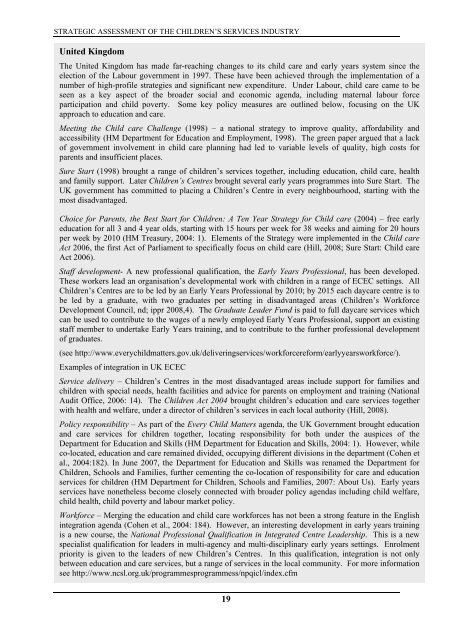A Strategic Assessment of the Children's Services Industry
A Strategic Assessment of the Children's Services Industry
A Strategic Assessment of the Children's Services Industry
- No tags were found...
You also want an ePaper? Increase the reach of your titles
YUMPU automatically turns print PDFs into web optimized ePapers that Google loves.
STRATEGIC ASSESSMENT OF THE CHILDREN’S SERVICES INDUSTRYUnited KingdomThe United Kingdom has made far-reaching changes to its child care and early years system since <strong>the</strong>election <strong>of</strong> <strong>the</strong> Labour government in 1997. These have been achieved through <strong>the</strong> implementation <strong>of</strong> anumber <strong>of</strong> high-pr<strong>of</strong>ile strategies and significant new expenditure. Under Labour, child care came to beseen as a key aspect <strong>of</strong> <strong>the</strong> broader social and economic agenda, including maternal labour forceparticipation and child poverty. Some key policy measures are outlined below, focusing on <strong>the</strong> UKapproach to education and care.Meeting <strong>the</strong> Child care Challenge (1998) – a national strategy to improve quality, affordability andaccessibility (HM Department for Education and Employment, 1998). The green paper argued that a lack<strong>of</strong> government involvement in child care planning had led to variable levels <strong>of</strong> quality, high costs forparents and insufficient places.Sure Start (1998) brought a range <strong>of</strong> children’s services toge<strong>the</strong>r, including education, child care, healthand family support. Later Children’s Centres brought several early years programmes into Sure Start. TheUK government has committed to placing a Children’s Centre in every neighbourhood, starting with <strong>the</strong>most disadvantaged.Choice for Parents, <strong>the</strong> Best Start for Children: A Ten Year Strategy for Child care (2004) – free earlyeducation for all 3 and 4 year olds, starting with 15 hours per week for 38 weeks and aiming for 20 hoursper week by 2010 (HM Treasury, 2004: 1). Elements <strong>of</strong> <strong>the</strong> Strategy were implemented in <strong>the</strong> Child careAct 2006, <strong>the</strong> first Act <strong>of</strong> Parliament to specifically focus on child care (Hill, 2008; Sure Start: Child careAct 2006).Staff development- A new pr<strong>of</strong>essional qualification, <strong>the</strong> Early Years Pr<strong>of</strong>essional, has been developed.These workers lead an organisation’s developmental work with children in a range <strong>of</strong> ECEC settings. AllChildren’s Centres are to be led by an Early Years Pr<strong>of</strong>essional by 2010; by 2015 each daycare centre is tobe led by a graduate, with two graduates per setting in disadvantaged areas (Children’s WorkforceDevelopment Council, nd; ippr 2008,4). The Graduate Leader Fund is paid to full daycare services whichcan be used to contribute to <strong>the</strong> wages <strong>of</strong> a newly employed Early Years Pr<strong>of</strong>essional, support an existingstaff member to undertake Early Years training, and to contribute to <strong>the</strong> fur<strong>the</strong>r pr<strong>of</strong>essional development<strong>of</strong> graduates.(see http://www.everychildmatters.gov.uk/deliveringservices/workforcereform/earlyyearsworkforce/).Examples <strong>of</strong> integration in UK ECECService delivery – Children’s Centres in <strong>the</strong> most disadvantaged areas include support for families andchildren with special needs, health facilities and advice for parents on employment and training (NationalAudit Office, 2006: 14). The Children Act 2004 brought children’s education and care services toge<strong>the</strong>rwith health and welfare, under a director <strong>of</strong> children’s services in each local authority (Hill, 2008).Policy responsibility – As part <strong>of</strong> <strong>the</strong> Every Child Matters agenda, <strong>the</strong> UK Government brought educationand care services for children toge<strong>the</strong>r, locating responsibility for both under <strong>the</strong> auspices <strong>of</strong> <strong>the</strong>Department for Education and Skills (HM Department for Education and Skills, 2004: 1). However, whileco-located, education and care remained divided, occupying different divisions in <strong>the</strong> department (Cohen etal., 2004:182). In June 2007, <strong>the</strong> Department for Education and Skills was renamed <strong>the</strong> Department forChildren, Schools and Families, fur<strong>the</strong>r cementing <strong>the</strong> co-location <strong>of</strong> responsibility for care and educationservices for children (HM Department for Children, Schools and Families, 2007: About Us). Early yearsservices have none<strong>the</strong>less become closely connected with broader policy agendas including child welfare,child health, child poverty and labour market policy.Workforce – Merging <strong>the</strong> education and child care workforces has not been a strong feature in <strong>the</strong> Englishintegration agenda (Cohen et al., 2004: 184). However, an interesting development in early years trainingis a new course, <strong>the</strong> National Pr<strong>of</strong>essional Qualification in Integrated Centre Leadership. This is a newspecialist qualification for leaders in multi-agency and multi-disciplinary early years settings. Enrolmentpriority is given to <strong>the</strong> leaders <strong>of</strong> new Children’s Centres. In this qualification, integration is not onlybetween education and care services, but a range <strong>of</strong> services in <strong>the</strong> local community. For more informationsee http://www.ncsl.org.uk/programmesprogrammess/npqicl/index.cfm19
















